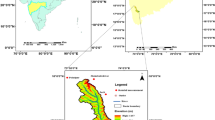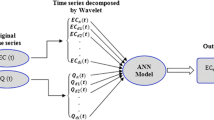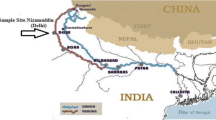Abstract
The accuracy of Artificial Neural Network (ANN), Adaptive Neuro-Fuzzy Inference System (ANFIS), wavelet-ANN and wavelet-ANFIS in predicting monthly water salinity levels of northwest Iran’s Aji-Chay River was assessed. The models were calibrated, validated and tested using different subsets of monthly records (October 1983 to September 2011) of individual solute (Ca2+, Mg2+, Na+, SO4 2− and Cl−) concentrations (input parameters, meq L−1), and electrical conductivity-based salinity levels (output parameter, µS cm−1), collected by the East Azarbaijan regional water authority. Based on the statistical criteria of coefficient of determination (R2), normalized root mean square error (NRMSE), Nash–Sutcliffe efficiency coefficient (NSC) and threshold statistics (TS) the ANFIS model was found to outperform the ANN model. To develop coupled wavelet-AI models, the original observed data series was decomposed into sub-time series using Daubechies, Symlet or Haar mother wavelets of different lengths (order), each implemented at three levels. To predict salinity input parameter series were used as input variables in different wavelet order/level-AI model combinations. Hybrid wavelet-ANFIS (R2 = 0.9967, NRMSE = 2.9 × 10−5 and NSC = 0.9951) and wavelet-ANN (R2 = 0.996, NRMSE = 3.77 × 10−5 and NSC = 0.9946) models implementing the db4 mother wavelet decomposition outperformed the ANFIS (R2 = 0.9954, NRMSE = 3.77 × 10−5 and NSC = 0.9914) and ANN (R2 = 0.9936, NRMSE = 3.99 × 10−5 and NSC = 0.9903) models.




















Similar content being viewed by others
References
Abdulshahed AM, Longstaff AP, Fletcher S (2015) The application of ANFIS prediction models for thermal error compensation on CNC machine tools. Appl Soft Comput 27:158–168. doi:10.1016/j.asoc.2014.11.012
Adamowski JF (2008) Development of a short-term river flood forecasting method for snowmelt driven floods based on wavelet and cross-wavelet analysis. J Hydrol 353(3–4):247–266. doi:10.1016/j.jhydrol.2008.02.013
Adamowski JF, Chan HG (2011) A wavelet neural network conjunction model for groundwater level forecasting. J Hydrol 407(1–4):28–40. doi:10.1016/j.jhydrol.2011.06.013
Adamowski JF, Sun K (2010) Development of a coupled wavelet transform and neural network method for flow forecasting of non-perennial rivers in semi-arid watersheds. J Hydrol 390(1–2):85–91. doi:10.1016/j.jhydrol.2010.06.033
Adamowski K, Prokoph A, Adamowski J (2009) Development of a new method of wavelet aided trend detection and estimation. Hydrol Process 23:2686–2696
Adamowski J, Adamowski K, Bougadis J (2010) Influence of trend on short duration design storms. Water Resour Manage 24:401–413
Adamowski J, Prokoph A, Adamowski K (2012a) Influence of the 11 year solar cycle on annual streamflow maxima in Southern Canada. J Hydrol 442:55–62
Adamowski J, Chan H, Prasher S, Sharda VN (2012b) Comparison of multivariate adaptive regression splines with coupled wavelet transform artificial neural networks for runoff forecasting in Himalayan micro-watersheds with limited data. J Hydroinf 3:731–744
Ahuja N, Lertrattanapanich S, Bose NK (2005) Properties determining choice of mother wavelet. IEEE Proc is Image Signal Process 152(5):659–664. doi:10.1049/ip-vis:20045034
Akansu A, Haddad R (1992) Multi-resolution signal decomposition: transforms, wavelets. Academic Press Inc, Orlando
Anctil F, Tape D (2004) An exploration of artificial neural network rainfall–runoff forecasting combined with wavelet decomposition. J Environ Eng Sci 3(Suppl.):S121–S128. doi:10.1139/s03-071
Araghi A, Adamowski J, Nalley D, Malard J (2015) Using wavelet transforms to estimate surface temperature trends and dominant periodicities in Iran based on gridded reanalysis data. J Atmos Res 11:52–72
Asghri Moghaddam A, Allaf Najib M (2006) Hydrogeologic characteristics of the alluvial tuff aquifer of northern Sahand Mountain slopes, Tabriz. Iran. Hydrogeol J 14(7):1319–1329. doi:10.1007/s10040-006-0036-1
Aussem A, Campbell J, Murtagh F (1998) Wavelet-based feature extraction and decomposition strategies for financial forecasting. J Comp Intel Fin. 6(2):5–12
Barzegar R (2014) The investigation of quantitative and qualitative of the Tabriz plain aquifer groundwater resources. MSc. Thesis. Dept. Natural Sciences, University of Tabriz
Barzegar R, Asghari Moghaddam A, Kazemian N (2015a) Assessment of heavy metals concentrations with emphasis on arsenic in the Tabriz plain aquifers, Iran. Environ Earth Sci 74(1):297–313. doi:10.1007/s12665-015-4123-2
Barzegar R, Asghari Moghaddam A, Najib M, Kazemian N, Adamowski J (2015b) Characterization of hydrogeologic properties of the Tabriz plain multilayer aquifer system, NW Iran. Arab J Geosci. doi:10.1007/s12517-015-2229-1
Belayneh A, Adamowski J, Khalil B, Ozga-Zielinski B (2014) Long-term SPI drought forecasting in the Awash River Basin in Ethiopia using wavelet-support vector regression models. J Hydrol 508:418–429
Borgonovo E, Plischke E (2015) Sensitivity analysis: a review of recent advances. Eur J Oper Res 248(3):869–887. doi:10.1016/j.ejor.2015.06.032
Butler C, Adamowski J (2015) Empowering marginalized communities in water resources management: addressing inequitable practices in Participatory Model Building. J Environ Manag 153:153–162
Campisi S, Adamowski J, Oron G (2012) Forecasting urban water demand via wavelet- denoising and neural network models. Case study: city of Syracuse, Italy. Water Resour Manag 26:3539–3558
Cannas B, Fanni A, See L, Sias G (2006) Data preprocessing for river flow forecasting using neural networks: wavelet transforms and data partitioning. Phys Chem Earth 31(18):1164–1171. doi:10.1016/j.pce.2006.03.020
Chiu SL (1994) Fuzzy model identification based on cluster estimation. J Intell Fuzz Sys 2(3):267–278. doi:10.3233/IFS-1994-2306
Cho KH, Sthiannopkao S, Pachepsky YA, Kim KW, Kim JH (2011) Prediction of contamination potential of groundwater arsenic in Cambodia, Laos, and Thailand using artificial neural network. Water Res 45(17):5535–5544. doi:10.1016/j.watres.2011.08.010
Christopoulou EB, Skodras AN, Georgakilas AA (2002) The ‘‘A Trous’’ wavelet transform versus classical methods for the improvement of solar images. In: Proceedings of the 14th international conference on digital signal processing, vol 2, Santorini, Greece, 1–3, July 2002, pp 885–888
Dawson CW, Wilby RL (2001) Hydrological modelling using artificial neural networks. Prog Phys Geogr 25(1):80–108. doi:10.1177/030913330102500104
De Giorgi MG, Congedo PM, Malvoni M, Laforgia D (2015) Error analysis of hybrid photovoltaic power forecasting models: a case study of mediterranean climate. Energy Convers Manag 100:117–130. doi:10.1016/j.enconman.2015.04.078
Einax JW, Aulinger A, Tumpling WV, Prange A (1999) Quantitative description of element concentrations in longitudinal river profiles by multiway PLS models. Fresenius’ J Anal Chem 363(7):655–661. doi:10.1007/s002160051267
Elhatip H, Kömür MA (2008) Evaluation of water quality parameters for the Mamasin dam in Aksaray City in the central Anatolian part of Turkey by means of artificial neural networks. Environ Geol 53(6):1157–1164. doi:10.1007/s00254-007-0705-y
Emamgholizadeh S, Kashi H, Marofpoor I, Zalaghi E (2014) Prediction of water quality parameters of Karoon River (Iran) by artificial intelligence-based models. Int J Environ Sci Tech 11(3):645–656. doi:10.1007/s13762-013-0378-x
Fijani E, Nadiri AA, Asghari Moghaddam A, Tsai F, Dixon B (2013) Optimization of DRASTIC method by supervised committee machine artificial intelligence to assess groundwater vulnerability for Maragheh-Bonab Plain Aquifer, Iran. J Hydrol 503:89–100. doi:10.1016/j.jhydrol.2013.08.038
Ghavidel SZZ, Montaseri M (2014) Application of different data-driven methods for the prediction of total dissolved solids in the Zarinehroud basin. Stoch Environ Res Risk Assess 28(8):2101–2118. doi:10.1007/s00477-014-0899-y
Govindaraju RS (2000) Artificial neural networks in hydrology. I, preliminary concepts. J Hydrol Eng 5(2):115–123. doi:10.1061/(ASCE)1084-0699(2000)5:2(115)
Grossmann A, Morlet J (1984) Decomposition of Hardy function into square integrable wavelets of constant shape. J Math Anal 5:723–736. doi:10.1137/0515056
Hadad K, Pourahmadi M, Majidi-Maraghi H (2011) Fault diagnosis and classification based on wavelet transform and neural network. Prog Nucl Energy 53(1):41–47. doi:10.1016/j.pnucene.2010.09.006
Haidary A, Amiri BJ, Adamowski J, Fohrer N, Nakane K (2013) Assessing the impacts of four land use types on the water quality of wetlands in Japan. Water Resour Manag 27:2217–2229
Halbe J, Pahl-Wostl C, Sendzimir J, Adamowski J (2013) Towards adaptive and integrated management paradigms to meet the challenges of water governance. Water Sci Technol 67:2651–2660
Halbe J, Adamowski J, Bennett E, Pahl-Wostl C, Farahbakhsh K (2014) Functional organization analysis for the design of sustainable engineering systems. Ecol Eng 73:80–91
Hernández E, Weiss G (1996) A First Course on Wavelets. CRC Press, Boca Raton
Inam A, Adamowski J, Halbe J, Prasher S (2015) Using causal loop diagrams for the initialization of stakeholder engagement in soil salinity management in agricultural watersheds in developing countries: a case study in the Rechna Doab watershed, Pakistan. J Environ Manag 152:251–267
Jain A, Indurthy SKVP (2003) Comparative analysis of event based rainfall runoff modeling techniques-deterministic, statistical, and artificial neural networks. J Hydraul Eng 8:93–98. doi:10.1061/(ASCE)1084-0699(2003)8:2(93))
Jang JSR (1993) ANFIS: adaptive network based fuzzy inference system. IEEE Trans Syst Man Cybern 23(3):665–685. doi:10.1109/21.256541
Junsawang P, Asavanant J, Lursinsap C (2007) Artificial Neural Network Model for Rainfall-Runoff Relationship, ASIMMOD, Chiang Mai, Thailand. http://www.mcc.cmu.ac.th/ASIMMOD2007/Paper/C07_P.%20Junsawang.pdf. Accessed 31 Dec 2015
Kant A, Suman PK, Giri BK, Tiwari MK, Chatterjee C, Nayak PC, Kumar S (2013) Comparison of multi-objective evolutionary neural network, adaptive neuro-fuzzy inference system and bootstrap-based neural network for flood forecasting. Neural Comput Appl 23:231–246. doi:10.1007/s00521-013-1344-8
Karran D, Morin E, Adamowski J (2014) Multi-step streamflow forecasting using data-driven non-linear methods in contrasting climate regimes. J Hydroinf 16(3):671–689
Kirchgässner G, Wolters J, Hassler U (2013) Introduction to modern time series analysis, 2nd edn. Springer, Berlin, p 331
Kişi O (2008) Stream flow forecasting using neuro-wavelet technique. Hydrol Proc 22(20):4142–4152. doi:10.1002/hyp.7014
Kişi O, Shiri J (2012) Reply to discussion of Precipitation forecasting using wavelet-genetic programming and wavelet-neuro-fuzzy conjunction models. Water Resour Manag 26(12):3663–3665. doi:10.1007/s11269-012-0060-y
Kolinjivadi V, Adamowski J, Kosoy N (2014) Recasting payments for ecosystem services (PES) in water resource management: a novel institutional approach. Ecosyst Serv 10:144–154
Lau KM, Weng H (1995) Climate signal detection using wavelet transform: how to make a time series sing. Bull Am Meteorol Soc 76(12):2391–2402. doi:10.1175/1520-477(1995)076<2391:CSDUWT>2.0.CO;2
Maheswaran R, Khosa R (2012a) Comparative study of different wavelets for hydrologic forecasting. Comput Geosci 46:284–295. doi:10.1016/j.cageo.2011.12.015
Maheswaran R, Khosa R (2012b) Wavelet-Volterra coupled model for monthly stream flow forecasting. J Hydrol 450–451:320–335. doi:10.1016/j.jhydrol.2012.04.017
Maier HR, Dandy GC (2000) Neural networks for the prediction and forecasting of water resources variables: a review of modelling issues and applications. Environ Model Softw 15(1):101–124. doi:10.1016/S1364-8152(99)00007-9
Mallat SG (1998) A wavelet tour of signal processing, 2nd edn. Academic Press, San Diego
Mehrotra K, Mohan CK, Ranka S (1997) Elements of artificial neural networks. The MIT Press, Boston
Mishra AK, Desai VR (2006) Drought forecasting using feed-forward recursive neural network. Ecol Model 198(1–2):127–138. doi:10.1016/j.ecolmodel.2006.04.017
Moosavi V, Vafakhah M, Shirmohammadi B, Behnia N (2013) A wavelet-ANFIS hybrid model for groundwater level forecasting for different prediction periods. Water Resour Manag 27(5):1301–1321. doi:10.1007/s11269-012-0239-2
Najah AA, El-Shafie A, Karim OA, Jaafar O (2011) Integrated versus isolated scenario for prediction dissolved oxygen at progression of water quality monitoring stations. Hydrol Earth Syst Sci 15:2693–2708. doi:10.5194/hess-15-2693-2011
Najah AA, El-Shafie A, Karim OA, Jaafar O (2012) Water quality prediction model utilizing integrated wavelet-ANFIS model with cross-validation. Neural Comput Appl 21(5):833–841. doi:10.1007/s00521-010-0486-1
Najah A, El-Shafie A, Karim OA, El-Shafie AH (2013) Application of artificial neural networks for water quality prediction. Neural Comput Appl 22(1, Suppl.):187–201. doi:10.1007/s00521-012-0940-3
Najah A, El-Shafie A, Karim OA, El-Shafie AH (2014) Performance of ANFIS versus MLP-NN dissolved oxygen prediction models in water quality monitoring. Environ Sci Pollut Res 21(3):1658–1670. doi:10.1007/s11356-013-2048-4
Nalley D, Adamowski JF, Khalil B (2012) Using discrete wavelet transforms to analyze trends in streamflow and precipitation in Quebec and Ontario (1954–2008). J Hydrol 475:204–228. doi:10.1016/j.jhydrol.2012.09.049
Nalley D, Adamowski JF, Khalil B, Ozga-Zielinski B (2013) Trend detection in surface air temperature in Ontario and Quebec, Canada during 1967–2006 using the discrete wavelet transform. Atmos Res 132–133:375–398. doi:10.1016/j.atmosres.2013.06.011
Nayak PC, Sudheer KP, Ranjan DM, Ramasastri KS (2004) A neuro fuzzy computing technique for modeling hydrological time series. J Hydrol 291:52–66. doi:10.1016/j.jhydrol.2003.12.010
Nievergelt Y (2001) Wavelets made easy. Birkhäuser, Boston
Noori R, Abdoli MA, Farokhnia A, Abbasi M (2009) Results uncertainty of solid waste generation forecasting by hybrid of wavelet transform-ANFIS and wavelet transform-neural network. Expert Syst Appl 36(6):9991–9999. doi:10.1016/j.eswa.2008.12.035
Nourani V, Alami MT, Aminfar MH (2009) A combined neural-wavelet model for prediction of watershed precipitation, Lighvanchai, Iran. Eng Appl Artif Intell 22(3):466–472. doi:10.1016/j.engappai.2008.09.003
Nourani V, Kisi Z, Mehdi K (2011) Two hybrid artificial Intelligence approaches for modeling rainfall-runoff process. J Hydrol 402(1–2):41–59. doi:10.1016/j.jhydrol.2011.03.002
Nourani V, Hosseini Baghanam A, Adamowski J, Gebremichael M (2013) Using self-organizing maps and wavelet transforms for space–time pre-processing of satellite precipitation and runoff data in neural network based rainfall-runoff modeling. J Hydrol 476:228–243. doi:10.1016/j.jhydrol.2012.10.054
Nourani V, Hosseini Baghanam A, Adamowski J, Kisi O (2014) Applications of hybrid Wavelet-Artificial Intelligence models in hydrology: a review. J Hydrol 514:358–377. doi:10.1016/j.jhydrol.2014.03.057
Olkkonen H (2011) Discrete wavelet transform-biomedical application. InTech, Rijeka. doi:10.5772/1818
Palani S, Liong SY, Tkalich P (2008) An ANN application for water quality forecasting. Marine Pollut Bull 56(9):1586–1597. doi:10.1016/j.marpolbul.2008.05.021
Parmar KS, Bhardwaj R (2015) River water prediction modeling using neural networks, fuzzy and wavelet coupled model. Water Resour Manag 29(1):17–33. doi:10.1007/s11269-014-0824-7
Partal T, Kişi Ö (2007) Wavelet and neuro fuzzy conjunction model for precipitation forecasting. J Hydrol 342:199–212. doi:10.1016/j.jhydrol.2007.05.026
Percival DB, Walden AT (2000) Wavelet methods for time series analysis. Cambridge University Press, New York
Pingale S, Khare D, Jat M, Adamowski J (2014) Spatial and temporal trends of mean and extreme rainfall and temperature for the 33 urban centres of the arid and semi-arid state of Rajasthan, India. J Atmos Res 138:73–90
Rahimikhoob A (2010) Estimation of evapotranspiration based on only air temperature data using artificial neural networks for a subtropical climate in Iran. Theor Appl Climatol 101(1–2):83–91. doi:10.1007/s00704-009-0204-z
Rajaee T, Mirbagheri SA, Zounemat-Kermani M, Nourani V (2009) Daily suspended sediment concentration simulation using ANN and neuro-fuzzy models. Sci Total Environ 407(17):4916–4927. doi:10.1016/j.scitotenv.2009.05.016
Rathinasamy M, Adamowski JF, Khosa R (2013) Multiscale streamflow forecasting using a new Bayesian Model Average based ensemble multi-wavelet Volterra nonlinear method. J Hydrol 507:186–200. doi:10.1016/j.jhydrol.2013.09.025
Rathinasamy M, Khosa R, Adamowski J, Ch S, Partheepan G, Anand J, Narsimlu B (2015) Wavelet-based multiscale performance analysis: an approach to assess and improve hydrological models. Water Resour Res. doi:10.1002/2013WR014650
Ravansalar M, Rajaee T (2015) Evaluation of wavelet performance via an ANN-based electrical conductivity prediction model. Environ Monit Assess. doi:10.1007/s10661-015-4590-7
Saadat H, Adamowski J, Bonnell R, Sharifi F, Namdar M, Ale-Ebrahim S (2011) Land use and land cover classification over a large area in Iran based on single date analysis of satellite imagery. J Photogramm Remote Sens 66(5):608–619
Sehgal V, Tiwari MK, Chatterjee C (2014) Wavelet bootstrap multiple linear regression based hybrid modeling for daily river discharge forecasting. Water Resour Manag 28(10):2793–2811. doi:10.1007/s11269-014-0638-7
Shirmohammadi B, Vafakhah M, Moosavi V, Moghaddamnia A (2013) Application of several data-driven techniques for predicting groundwater level. Water Resour Manag 27(2):419–432. doi:10.1007/s11269-012-0194-y
Singh KP, Basant A, Malik A, Jain G (2009) Artificial neural network modeling of the river water quality, a case study. Ecol Model 220(6):888–895. doi:10.1016/j.ecolmodel.2009.01.004
Smith M (1994) Neural networks for statistical modelling. Van Nostrand Reinhold, New York, p 235
Straith D, Adamowski J, Reilly K (2014) Exploring the attributes, strategies and contextual knowledge of champions of change in the Canadian water sector. Can Water Resour J 39(3):255–269
Tiwari M, Adamowski J (2014) Urban water demand forecasting and uncertainty assessment using ensemble wavelet-bootstrap-neural network models. Water Resour Res 49(10):6486–6507
Tiwari M, Adamowski J (2015) Medium-term urban water demand forecasting with limited data using an ensemble wavelet-bootstrap machine-learning approach. J Water Resour Plan Manag 141(2):04014053
Tiwari M, Chatterjee C (2011) new wavelet–bootstrap–ANN hybrid model for daily discharge forecasting. J Hydroinf 13(3):500–519. doi:10.2166/hydro.2010.142
Torrence C, Compo GP (1998) A practical guide to wavelet analysis. Bull Am Meteorol Soc 79:61–78. doi:10.1175/1520-0477(1998)079<0061:APGTWA>2.0.CO;2
Xu L, Liu S (2013) Study of short-term water quality prediction model based on wavelet neural network. Math Comput Model 58(3–4):807–813. doi:10.1016/j.mcm.2012.12.023
Yeniguna K, Ecer R (2012) Overlay mapping trend analysis technique and its application in Euphrates Basin, Turkey. Meteorol Appl 20(4):427–438. doi:10.1002/met.1304
Zounemat-Kermani M, Teshnehlab M (2008) Using adaptive neuro-fuzzy inference system for hydrological time series prediction. Appl Soft Comput 8(2):928–936. doi:10.1016/j.asoc.2007.07.011
Acknowledgments
The authors would like to acknowledge the East Azarbaijan regional water authority for supplying the existing relevant data. The authors are grateful to the Dr. Thierry Alex Mara for kind help in improving the manuscript.
Author information
Authors and Affiliations
Corresponding author
Rights and permissions
About this article
Cite this article
Barzegar, R., Adamowski, J. & Moghaddam, A.A. Application of wavelet-artificial intelligence hybrid models for water quality prediction: a case study in Aji-Chay River, Iran. Stoch Environ Res Risk Assess 30, 1797–1819 (2016). https://doi.org/10.1007/s00477-016-1213-y
Published:
Issue Date:
DOI: https://doi.org/10.1007/s00477-016-1213-y




